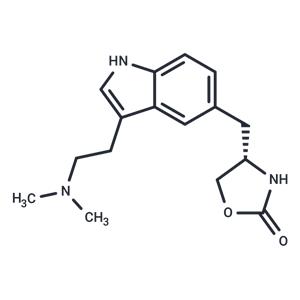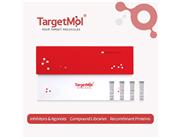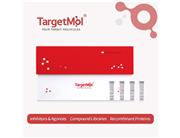| Name | Zolmitriptan |
| Description | Zolmitriptan (311C90) selectively binds to and activates serotonin (5-HT) 1B receptors expressed in intracranial arteries and 5-HT 1D receptors located on peripheral trigeminal sensory nerve terminals in the meninges and central terminals in brainstem sensory nuclei. Zolmitriptan is a member of the triptan class of agents with anti-migraine properties. Receptor binding results in constriction of cranial vessels, reduction of vessel pulsation and inhibition of nociceptive transmission, thereby providing relief of migraine headaches. Zolmitriptan may also relieve migraine headaches by inhibition of pro-inflammatory neuropeptide release. |
| In vitro | Zolmitriptan produces concentration-dependent contractions of primate basilar artery and human epicardial coronary artery rings. Zolmitriptan displays high affinity at human recombinant 5-HT1D (formerly 5-HT1D alpha) and 5-HT1B (formerly 5-HT1D beta) receptors in transfected CHO-K1 cell membranes. [1] Zolmitriptan increases I(K) in a concentration-dependent manner (maximum increase 16.3%) with a pD(2) value of 7.03 in C6 glioma cells expressing recombinant human 5-HT(1B) receptor. Zolmitriptan-induced increases in I(K) are prevented by the calcium chelator, EGTA (5 mM) when included in the patch pipette in C6 cells expressing cloned human 5-HT(1B) receptors. [2] |
| In vivo | Zolmitriptan (3-30 mg/kg, i.v.) administrated ten minutes before unilateral electrical stimulation of the trigeminal ganglion causes a dose-dependent inhibition of [125I]-albumin extravasation within the ipsilateral dura mater in anaesthetized guinea-pigs. [1] Zolmitriptan (10-1000 mg/kg, i.v.) selectively reduces arteriovenous-anastomotic (AVA) conductance producing a maximum decrease of 92.5%. Zolmitriptan also produces a modest reduction in extra-cerebral conductance (23.9% maximum reduction at 30 mg/kg, i.v.), but is without effect on cerebral conductance. Zolmitriptan (1-30 mg/kg, i.v.) produces dose-dependent decreases in ear microvascular conductance (15% to 60%) which mirror decreases in carotid arterial conductance in anaesthetised cats. [3] Zolmitriptan exerts behaviorally specific anti-aggressive effects in mice. Zolmitriptan also decreases alcohol-heightened aggression with equal efficacy in mice. [4] |
| Storage | Powder: -20°C for 3 years | In solvent: -80°C for 1 year | Shipping with blue ice. |
| Solubility Information | DMSO : 55 mg/mL (191.4 mM)
Ethanol : 28.7 mg/mL (100 mM)
|
| Keywords | extravasation | 5-HT,migraine | synaptic | muscle | neurogenic | 5-HT Receptor | input | Serotonin Receptor | motoneurons | Endogenous Metabolite | serotonin | Inhibitor | inhibit | triptans | spasms | spasticity | 5-hydroxytryptamine Receptor | Zolmitriptan |
| Inhibitors Related | Alverine citrate | Olanzapine | Dapoxetine hydrochloride | CLOZAPINE N-OXIDE | Amitriptyline hydrochloride | Cloperastine hydrochloride | Trazodone hydrochloride | Mianserin hydrochloride | Fluoxetine hydrochloride | Cinchonidine |
| Related Compound Libraries | Pain-Related Compound Library | Bioactive Compound Library | Anti-Neurodegenerative Disease Compound Library | Membrane Protein-targeted Compound Library | Drug Repurposing Compound Library | FDA-Approved Drug Library | Anti-Cancer Approved Drug Library | Bioactive Compounds Library Max | GPCR Compound Library | Anti-Cancer Drug Library |

 United States
United States



